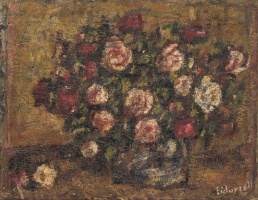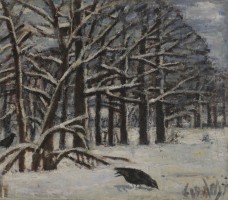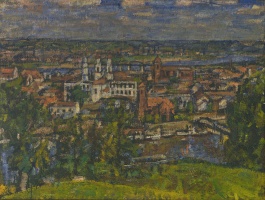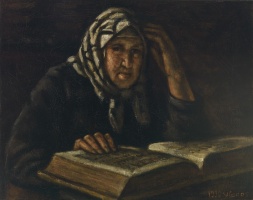


Kaunas from Aleksotas Hill
| Author: |
Vladas Eidukevičius (1891–1941)  |
| Created: | 1930 |
| Material: | canvas |
| Technique: | oil |
| Dimensions: | 79 × 100 cm |
The interim capital could not equal Vilnius in terms of its historical, architectural and sacral heritage, or in the continuity of its cultural traditions. However, by the end of the 1920s, Kaunas was undergoing intense modernisation and was turning into a thriving metropolis. This was also reflected in works of art. The Vytautas the Great (Aleksotas) Bridge, seen in paintings by Vladas Eidukevičius (1891–1941) and Jonas Buračas (1898–1977), was constructed in 1930; and in 1931 and 1932, Laisvės Avenue was given a major overhaul and resurfaced with tarmac.
The new iron bridge, along with the oldest passenger wharf in Kaunas, became one of the symbols of modernisation and progress. It was a hub for river traffic, and a popular leisure spot for the city’s residents. It is no wonder that this construction became one of the most frequently portrayed objects in pictures by Kaunas artists.
Text authors Dovilė Barcytė and Ieva Burbaitė
Source: Law firm Valiunas Ellex art album KAUNAS–VILNIUS / 1918–1945 (2021). Compilers and text authors Dovilė Barcytė and Ieva BurbaitėExpositions: "The Nomad Artist", 18 Feburary – 17 April 2016, Vilnius Picture Gallery, Vilnius. Curator - Rima Rutkauskienė. "A Glance at the History of Lithuanian Art from Užupis", 30 August 2018 – 1 June 2019, Lithuanian Art Centre TARTLE (Užupio St. 40, Vilnius). Curator Giedrė Jankevičiūtė; "1918-1945 / Kaunas-Vilnius", 27 August 2020 – 21 August 2021, Lithuanian Art Centre TARTLE (Užupio St. 40, Vilnius). Curators Dovilė Barcytė and Ieva Burbaitė.










